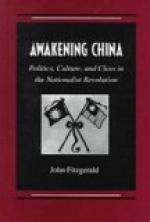Continuing our journey through half a dozen considerable cities, at one of which, Shunteh-fu, an American mission has recently been opened, we reach the borders of the province of Honan.
[Page 41] CHAPTER VIII
PROVINCE OF HONAN
A Great Bridge—K’ai-fung-fu—Yellow Jews
Passing the border city of Weihwei-fu, we find ourselves arrested by the Hwang Ho—not that we experience any difficulty in reaching the other bank; but we wish to indulge our curiosity in inspecting the means of transit. It is a bridge, and such a bridge as has no parallel on earth. Five miles in length, it is longer than any other bridge built for the passage of a river. It is not, however, as has been said, the longest bridge in the world; the elevated railway of New York is a bridge of much greater length. So are some of the bridges that carry railways across swamp-lands on the Pacific Coast. Bridges of that sort, however, are of comparatively easy construction. They have no rebellious stream or treacherous quicksands to contend with. Caesar’s bridge over the Rhine was an achievement worthy to be recorded among the victories of his Gallic wars; but it was a child’s plaything in comparison with the bridge over the Yellow River. Caesar’s bridge rested on sesquipedalian beams of solid timber. The Belgian bridge is supported on tubular piles of steel of sesquipedalian diameter driven by steam or screwed down into the sand to a depth of fifty feet.
There have been other bridges near this very spot [Page 42] with which it might be compared. One of them was called Ta-liang, the “Great Bridge,” and gave name to a city. Another was Pien-liang, “The Bridge of Pien,” one of the names of the present city of K’ai-fung-fu. That bridge has long since disappeared; but the name adheres to the city.
What an unstable foundation on which to erect a seat of empire! Yet the capital has been located in this vicinity more than once or twice within the last twenty-five centuries. The first occasion was during the dynasty of Chou (1100 B. c.), when the king, to be more central, or perhaps dreading the incursions of the Tartars, forsook his capital in Shensi and followed the stream down almost to the sea, braving the quicksands and the floods rather than face those terrible foes. Again, in the Sung period, it was the seat of government for a century and a half.
The safest refuge for a fugitive court which, once established there, has no reason to fear attack by sea or river, it is somewhat strange that in 1900 the Empress Dowager did not direct her steps toward K’ai-fung-fu, instead of escaping to Si-ngan. Being, however, herself a Tartar, she might have been expected to act in a way contrary to precedents set by Chinese dynasties. Obviously, she chose the latter as a place of refuge because it lay near the borders of Tartary. It is noteworthy that a loyal governor of Honan at that very time prepared a palace for her accommodation in K’ai-fung-fu, and when the court was invited to return to Peking, he implored her not to risk herself in the northern capital.




